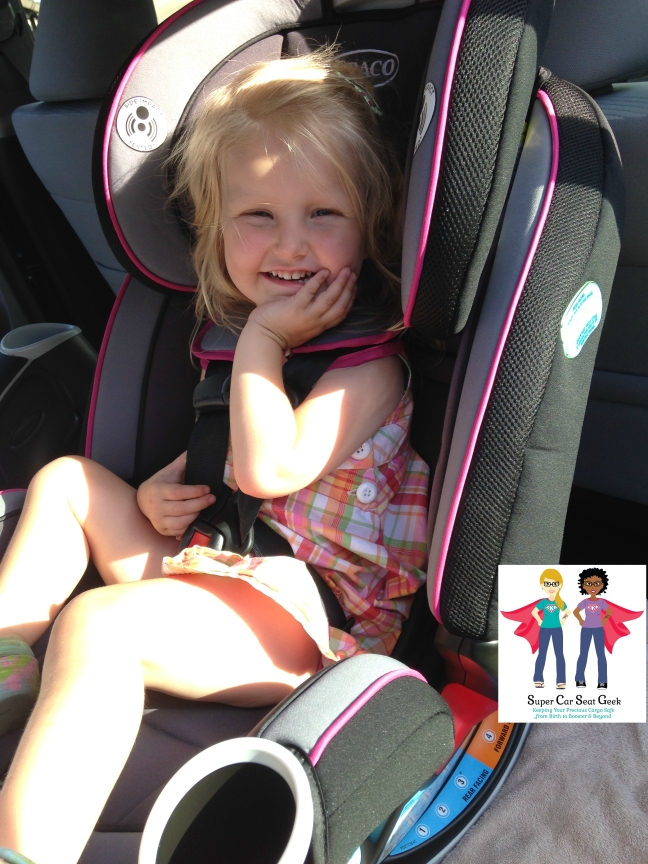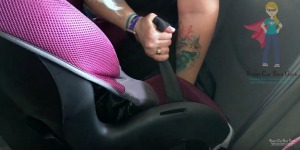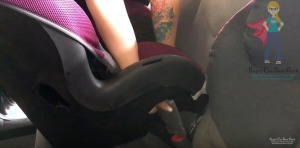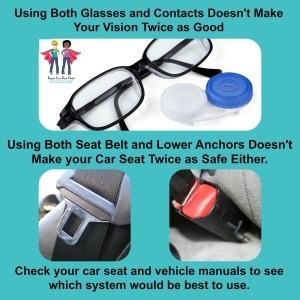
It’s important to remember that regardless of where you live, laws rarely require best practice across the board. This often leaves caregivers feeling confused, so I included some suggestions on this infographic.




One of the most common complaints that I hear from caregivers is how much they struggle to get a tight car seat installation. Many caregivers feel as though they’re physically unable to do it, despite not necessarily having any physical limitations. Installing a car seat can feel intimidating and overwhelming. However, contrary to popular belief, getting the car seat installed correctly has very little to do with brute strength, and almost everything to do with leverage. While every car seat and vehicle is different – and have their own subtle nuances – I’m going to share some of my favorite tricks which work well for most configurations.
Since leverage is one of your biggest allies, you want to take full advantage of it. Most of the time that will mean that you want to pull the slack both toward you and parallel to the belt path of the car seat.

For example, if you’re installing a car seat using lower anchors (LATCH), you’ll want to look to see where the adjuster is on the lower anchor strap. It will be on the same side of the strap where the “tail” of the strap is located. Most of the time, I find that caregivers will grab ahold of the tail on the outside of the seat and try to tighten it by pulling it away from the car seat. While this seems perfectly logical, this does not utilize the available leverage very effectively. Instead, when possible, you’ll want to position yourself on the opposite side of the car seat that the adjuster piece is located on so that you can pull that “tail” toward you, parallel to the belt path of the car seat. For even better leverage, try pulling the strap inside of the car seat’s belt path and pulling from there. Many times this can be accomplished by pulling the cover of the car seat back at the belt path, and pulling the tail inside of the belt path. After the seat is installed tightly, simply replace and re-secure the cover.

Installing a car seat with a seat belt is very similar. You can often utilize the same method, but instead of pulling on the lower anchor strap’s “tail”, you’ll be pulling the vehicle shoulder belt toward you, over the car seat’s belt path, to better remove all of the slack from the lap belt portion of the seat belt. (Don’t forget to check your manuals for instructions on how to lock the seat belt.)
Remember to only check for movement directly at the applicable belt path on the car seat, and only by using about the same amount of force with which you would use to give somebody a firm handshake. If the car seat moves 1” or less directly at the appropriate belt path, then the car seat is installed tightly. If it’s moving more than that, then repeat the steps above.
Before you install your car seat, please be sure to consult your child safety seat’s owner’s manual for seat-specific installation instructions, as well as your vehicle owner’s manual for vehicle-specific installation instructions. And of course, don’t forget to schedule a seat check with a certified Child Passenger Safety Technician.

The responsibilities that come with parenthood can be overwhelming at times. There are so many different things to learn and frequently, when you feel like you’ve finally mastered one thing, something changes, and you need to re-learn it.
Protecting your child in the car is one of the many things that we parents must learn how to do. Most of us get in and out of the car multiple times a day. It is a mundane task, so we take it for granted, forgetting that there are inherent risks in and around the car. Parents today have busy lives and countless things to do and remember. We are usually running around, trying desperately to get from Point A to Point B safely and on time. It’s easy to forget the many risks we face each time we climb into the car. The fact however, remains that car crashes are the leading cause of death for children in the U.S. Most parents feel like their child is in the correct car seat and that their car seat is installed and used correctly, but one study has shown a misuse rate of as high as 92%¹.
While I certainly can’t cover everything there is to know about child passenger safety in one brief article, I’m going to share some basic tips which are easy to implement right now. Please contact me if you have further questions or would like to schedule an appointment to have your child’s car seat or booster checked.
1) Harness Placement
When a child is rear facing, the harness (car seat straps) should be coming out of the car seat directly at, or below the child’s shoulders. (Remember, a child should be rear facing until they are at least two years old.)
When a child is forward facing, the harness should be coming from at or above a child’s shoulders. (Remember, a child should be harnessed until they are at least five years old.)
2) Pinch Test
Ensure that the harness is flat and straight, with no twists , and then remove all of the slack . Pay special attention to ensure that there’s no slack “hiding” down by the child’s hips. The harness will be snug enough when it passes “the pinch test,” meaning that you’re unable to pinch a fold in the harness at the child’s shoulders/collarbone.
3) Chest Clip Placement
The harness retainer clip (more commonly referred to as the chest clip) should always be directly on top of the child’s sternum (breast bone). The top of it should be aligned with the child’s armpits.
4) Inch Test
The proper way check that the car seat is installed tightly, is is to grab the seat directly, and only at the belt path, and give it a wiggle with about the same force as you’d use in a firm handshake. The car seat should not move more than 1” in any direction at the belt path. (If the seat is installed rear facing, the belt path will be under the child’s feet/lower legs. If the car seat is installed forward facing, the belt path will be behind the child’s back.) Remember—if the car seat is forward facing, you’ll also want to secure the tether strap to the designated tether anchor for that seating position, and remove all of the slack from the tether strap.
5) Read Your Manuals
Your child’s safety seat can’t do its job if it’s not used correctly. Every car seat will have different rules for how and when to make adjustments to the harness, buckle, padding, etc. The manual will tell you precisely how to install the safety seat depending on the vehicle, the location in the vehicle the weight of the child. It is critical to read the manual for your child’s seat as well as the child safety seat section in your vehicle’s manual. I strongly recommend re-reading your manual periodically, especially when you need to uninstall, clean, make adjustments or reinstall the seat. If you’re confused about something, you can reach out to a Child Passenger Safety Technician (CPST) such as myself for clarification, or to the car seat manufacturer.
While there are many things to be aware of and to learn, my job as a CPST is to help you keep your child safe. Nothing makes me happier than helping caregivers feel empowered in their abilities to do that. I offer a variety of services to assist in every aspect of this journey. Super Car Seat Geek’s exclusive Concierge Service will help pair you with the very best car seat options for your particular child, vehicle and budget. Since the right seat is only a fraction of the equation, a private Car Seat Check will ensure that you understand how to install and use your child’s seat correctly every time they get buckled up.
If you have questions or would like to set up a Concierge Service session, or a private Seat Check, please contact me at facebook.com/SuperCarSeatGeek or email me at SuperCarSeatGeek@gmail.com








*Shower Cap style buntings are also a safe way to keep baby warm and require no alterations.

In September, both Abbie and I attended a seminar at Children’s Specialized Hospital in New Jersey for the transportation of children with special health care needs, while this is not a certification, we are listed as having completed the two day course.
Our instructor, Jackie Stackhouse Leach, was a wealth of information and lead the class in hands on, practical approaches to learning about illnesses, conditions and transportation needs of a more fragile population of children. The class covered some of the most common health needs like premature infants, apnea, g-tubes casts, children on the Autistic spectrum, cerebral palsy, scoliosis, spina bifida and some other less common ailments such as Pierre Robin sequence, Osteogenesis Imperfecta, Achondroplasia and children with non-permanent health care needs like casts, trachs, feeding tubes and the necessity of other medical equipment while traveling.
With both Super Car Seat Geeks being in a private setting, it is unlikely that we will encounter some of the more challenging cases of transporting children, but all aspects of the class did translate to helping families with transporting children whether with special health care needs or behavioral needs. We learned about a variety of traditional and medical seats that would be able to assist in transporting children and learned tips and tricks for behavioral issues in transporting your mini escape artists!
If your child has a medical condition, upcoming surgery or other unique challenges – contact us at Super Car Seat Geek so that we can assist you in your child passenger needs.